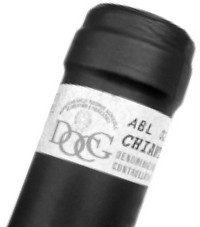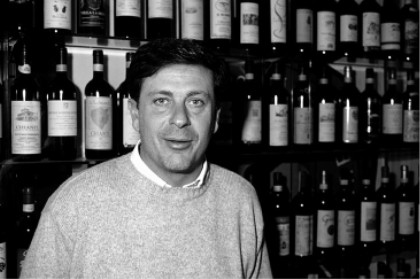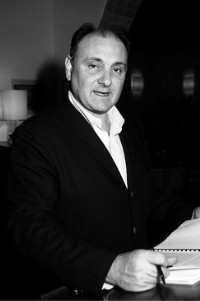 Chianti. That's the name of the most famous wine in the world. Everyone once knew that Chianti came from Tuscany, that it was bottled in reed-wrapped belly bottles, and that it was a fruity, cheerful drop for light-hearted dining moments. These certainties have been permanently shattered over the last thirty years. First, the Chianti became thinner and thinner and more and more sour, then the Tuscans smashed the bulbous bottle called Fiasco. And again and again, one hears that the Chianti label is also stuck on non-Tuscan wine by unscrupulous bottlers. Merum shows how the Chianti is mercilessly grounded by large bottlers and distributors.
Chianti. That's the name of the most famous wine in the world. Everyone once knew that Chianti came from Tuscany, that it was bottled in reed-wrapped belly bottles, and that it was a fruity, cheerful drop for light-hearted dining moments. These certainties have been permanently shattered over the last thirty years. First, the Chianti became thinner and thinner and more and more sour, then the Tuscans smashed the bulbous bottle called Fiasco. And again and again, one hears that the Chianti label is also stuck on non-Tuscan wine by unscrupulous bottlers. Merum shows how the Chianti is mercilessly grounded by large bottlers and distributors.
Germans love Chianti. Every year they polish off 25 million bottles. But apparently, they are not willing to pay much for their favorite wine. The discount giant Aldi is convinced that the pain threshold of its customers is two euro and has been offering Chianti at this dumping price for more than two years. Which would not be scandalous if the price for Chianti in Tuscany had not exactly doubled during the same period!
Something can't be right, someone is putting money on it: The discounters? The suppliers? Or is it just the customers who are being ripped off again for the sake of simplicity?
In fact, in order for the calculation of suppliers, importers and discounters to work out, the guilelessness of the consumer and the definition of what "Chianti" has to be have to be strained: While between mid-1999 and mid-2000 - Chianti barrel wine prices were at their absolute lowest - golden noses could be earned with the Chianti business, the margins became tighter and tighter from autumn 2000 on. The price the bottlers then had to pay for a liter of Chianti in summer 2001 was exactly twice as high as twelve months before.
Even with a lot of goodwill, it cannot be explained how a bottle of Chianti DOCG, which costs the bottler two euro in Italy, can also be offered for two euro on German shelves.
The Italian financial police, too, did not find a plausible explanation for this generosity of the German discounters and their Italian suppliers and paid a visit to the well-known Castellani bottler and Aldi supplier in the province of Pisa in a large squad.

Chianti president Luca Giannozzi: "It's impossible that the people in charge of the German food trade don't realize that they don't get real Chianti for these prices"
Roberto Castellani denies any blame and explains the intervention of the "Guardia_di_Finanza" as follows: "Since we are in the period of contract renewals, our unscrupulous Italian competitors have invented a story that doesn't exist. In doing so, they tried to put a routine inspection, which is carried out every year at the end of the harvest by officials of the tax authorities, in the wrong light."
However, the "unscrupulous" competition cannot be blamed for the "routine inspection" - according to Castellani's own statement, it took "only" eight days. Those who, like Castellani and consorts, deliver huge amounts of wine at impossible prices, have to expect to attract the attention of the control organs even without any external help: At the beginning of 2000, the minimum production price of a 0.75 liter bottle of Chianti for the Tuscan bottler was 1.30 euro; due to the increase of cask wine prices, this cost price increased rapidly and relentlessly to rise to the current 1.90 euro per bottle.
Today, no one who has to buy wine, bottles, corks, cartons, and labels can produce a bottle of Chianti for less than 1.90 euro. If he then wants to earn ten cents, he can offer a bottle for two euro at best.
If you add another ten cents for the transport to Germany, the cheapest of all cheap Chianti costs the discounter - before importer commissions - 2.10 Euros. Undeterred, however, Aldi offers Chianti DOCG - or what it is called - for 1.99 euro.
The spark that unleashes the criminal energy of a winery owner is often a self-imposed constraint. An example: A cantina, let's call it "XY", signs a supply contract with a customer for one million liters of Chianti at a tightly calculated but feasible price at the moment of the offer.
Of course, this large quantity of wine - it could be millions of litres! - is not in the cellar of the supplier, but still has to be bought on the market. Since at this point it is still uncertain whether the customer will sign the supply contract, it is necessary to wait with the procurement.
Let's assume that the price of cask wine has risen more than expected in the time between the offer and the moment when the customer gives our Cantina XY the contract. The distressed Cantina XY is now faced with the choice to either buy real Chianti more expensive than it can sell it, or to pay the customer the penalty stipulated in the contract and lose face. In view of the enormous amounts at stake, both options can put our Cantina XY in existential distress.
To avoid a disaster, there is only one way out: to "correct" the documents, to deliver to the customer at contract conditions, and to hope that nobody suspects anything.
Due to the increase in the price of bulk wines at the time of contract renewals, the suppliers of the big discount chains often get into trouble. The reason why cask wine prices show such extreme swings just in this critical phase is this: When a giant like Aldi needs five million bottles, not only one supplier is asked for his offer, but always several. This suddenly creates a large virtual demand in the production area, because several bottlers are looking for the quantities they need on the bulk wine market at the same time.
 |
"Germans are not afraid to buy Chianti at a price for which fraud must be suspected." |
Control insufficient for DOC/DOCG wines
The temptation to cheat is great, a Tuscan bottler admits: "A tank truck with Chianti is worth 80,000 euro, one with table wine costs 20,000 euro. You only have to correct the documents and earn 60,000 euro overnight! If you're in trouble, you might not be afraid to do something like that. Especially since the risk of being discovered is low ".
As early as in 1999, when Tuscan bottlers hawked five million bottles of "Chianti" to Germany for one euro per bottle, the control authorities became suspicious and started to search the houses of Bartali and Coli, the Castellani competitors, and made arrests. According to a proven method, papers were "rewritten" and red wines from other regions were refined to Chianti DOCG.
For the second time within two years, the Italian control system shows its teeth. However, both cases involved such huge amounts of wine and such striking inconsistencies that the activity of the wine control is not surprising.
What is unsatisfactory about the Italian wine control, however, is that the controls are not carried out preventively but always retroactively and not systematically but only randomly. This might be acceptable for table wines, but for wines with controlled, and even more for those with "guaranteed" origin, a preventive, systematic control would be a matter of course. (See on the topic of controls: Chianti DOCG with "G" as in "guaranteed")
Italian criticism of German buyers
Every few years, a wine counterfeit bursts in Italy. Every time, one is curious to know which persons and companies have taken on the import and distribution of such wines in Germany. But one hopes for news in vain, it is always the same people who are fishing in the mud, and it is always the same discount chains on whose shelves the consumer fraud is carried out.
 |
Casare Cecci: "I was present at price negotiations for Chianti, where they haggled for half a euro cent per liter. In such a commercial environment there are no prospects for the future." |
From the ranks of the Tuscan Cantine Sociali, German buyers are accused of not caring about anything except price. "They don't care where the wine comes from", Maurizio Cremonini Bianchi, director of the Chiantigiane in Tavarnelle, says bitterly. "It is not serious towards the consumer if a discount chain cannot prove the authenticity of a wine beyond a copy of the supplier's invoice"
And further: "The Germans are not afraid to buy Chianti at a price for which fraud has to be suspected" (Chiantigiane is a consortium founded by five Tuscan cellar cooperatives. It has 3500 hectares of vines and markets 16 million bottles, 5 million of which are Chianti)
But not only the cooperatives, also the private ones complain about the Germans. The Cecchi wine house in Castellina produces more than three million bottles of Chianti, but has not delivered a single bottle to Germany for years. "In Germany, we cannot compete with Chianti. Even though our house has grown up with Chianti, we had to leave this business to the competition in Germany. Besides the price, the Germans don't want to hear anything about this product", Cesare Cecchi complains. "In Germany, we talk about our wines from Montefalco, from the Maremma, about Chianti Classico, even a sales talk about Sangiovese IGT is more interesting".
Cecchi: "I was present at price negotiations for Chianti, where they haggled for half a euro cent per liter. This is completely absurd. In such a commercial environment, there are no prospects for the future. In the UK, too, business with the discounters is tough, but there is a certain cooperation, longer-term thinking is possible. Unlike the Germans, the English have the quirk of quality control: they come to the cellar once or twice a year to see who is producing their wine. In contrast, I can't remember ever having welcomed a German buyer in my cellar."
As in Germany, the majority of Chianti in England is distributed via grocery stores. Whereas the Germans are accused of conducting their business contacts only via telephone and fax machine, English buyers are credited with scrutinizing the seriousness of the supplier and the wine quality before they commit themselves to a supply contract.
Cremonini Bianchi (Chiantigiane): "It is difficult to do business with the English. Although we are already ISO-9000 certified, an English supermarket chain interested in our wines ordered another certification by an English company before delivery."
Italian Chianti suppliers assure Merum that they are often not even asked for samples before deliveries to Germany. Bottler
At the established wine house Cecchi, it sounds similar: Cremonini Bianchi (Chiantigiane)
Luca Giannozzi, president of the Chianti protection consortium in Florence, also directs heavy reproaches at the German discounters:
And since fake Chianti is only produced because there is demand for it, Giannozzi concludes: "Possibly, some German buyers are in cahoots with the fraudsters here!" Cremonini Bianchi: "The big groups buy Chianti at impossible prices. They're literally looking for trouble!"
Courageous colleague
Hermann Pilz, editor-in-chief of the German trade journal "Weinwirtschaft", wanted to find out on the spot in Tuscany what is behind the impossible Chianti prices. His investigations led him, too, to the conclusion that the reason for the low prices of the German food trade is not to be found in exuberant altruism but in unlawful actions.
Mr. Pilz shows courage with his indignation, which is not only directed at the Italians, but also at buyers and distributors of wines, where illegality has to be suspected as a production factor. He is the only one who dares to raise his voice loudly against the powerful German discounters: Appreciation for the courageous journalist is then also expressed by those responsible of the Italian cellar cooperatives and of trading companies. The interviewed producers unanimously emphasize that the fraud with DOCG wines was only possible because German buyers and discounters played the dirty game.
Aldi: Secret Padron of Chianti
The future of Chianti is fatefully linked to the German food trade. It is estimated that a quarter of the 100 million bottles produced go to Germany. However, the 25 million bottles are not bought by hundreds of importers and specialist retailers, but by a few individuals who take care of the purchasing for the few giants of the German food trade.
There are probably not much more than ten people in Germany who decide the fate of a whole quarter of the most important Italian DOC wine in terms of volume. But whoever controls 25 percent of the sales of Chianti, the well-being of the whole appellation depends on.
What is the lowest price at which an honest bottler can offer a bottle of Chianti today? is the opinion of the Tuscan cooperation.
Cesare Cecchi: "Two euro a bottle? If I would commit myself to this price for a delivery, I would have to fear for my reputation in my own family. Purely mathematically, this price is possible: 1.5 euro wine value (0.75 lt.) and 0.5 euro material. But what kind of future can it be to build with such business?" The director of the Chianti Consortium, Paolo Lazzeri
During all the time that the Chianti price on German shelves was and is kept unchanged low, the cask wine price in Tuscany did somersaults. Apart from the fact that low bulk wine prices deprive the cantine sociali and their grape suppliers of their income, each price collapse also causes problems for the serious marketers.
The Cantine Leonardo in Vinci, a smaller cooperative with 180 members and 500 hectares of vineyards, markets practically its whole production itself. Sales director Giovanni Nencini: If the price of bulk wine decreases, the producers marketing themselves on the market are in trouble due to the price competition. Only the pure bottlers without production are then at an advantage. The low prices of the competition make our wines too expensive.
But low prices also cause production to die off. The rural exodus of the young, once completed, is irreversible. And since the money and the courage for investments are missing, the production is becoming less and less and more expensive due to the outdated, increasingly thinning vineyards.
Maurizio Cremonini Bianchi from the Chiantigiane: "With the prescribed maximum yield of 9000 kilos of grapes per hectare, a liter of Chianti should not cost less than EUR 1,80. Only if the price settles between EUR 1.80 and 2.10, a sufficient income can be guaranteed for the producers and the production can be kept at the current level."
The future of the bulk wine price
After the past vintage was already decimated by early frost and summer drought, the financial police caused additional shortages of Chianti by once again putting a stop to the miraculous multiplication of wine. Franco Ambrosino, director of the Cantine Leonardo, is of the opinion
Luca Giannozzi, vintner and president of the Chianti consortium, is more pessimistic
Cesare Cecchi's prediction sounds no less resigned: "Unfortunately, the ups and downs of the cask wine prices are not only the past but also the future of Chianti. We have already experienced such a crazy price increase between 1996 and 1998, and now the price is again at a record high. I'm convinced that the price will go down again within the next six months. There is no other way, because at today's price there is simply less to sell."
Why is this up and down of Chianti so extreme? Cecchi: "Because the elasticity between supply and demand is so great. If a big chain in Germany decides to push Chianti, it can mean an increase in sales of several million bottles, and in our production area it can fuel demand and prices. Instability in prices is a normality wherever large quantities are available."
No hope for Chianti
Chianti has little chance of polishing up its image. The sector is disproportionately fragmented: a hundred large bottlers in Tuscany and outside, around 2000 smaller marketers, including wine houses, cellar cooperatives and self-marketers, 6000 grape producers. The whole spread over eight sub-appellations and six provinces.
Chianti comes from an area without territorial unity, which is rather a residual entity, a real non-appellation, a catch basin for everything that is not called Carmignano, Montalcino, Montepulciano, Chianti Classico or Chianti Rùfina. Today, Chianti has only slightly more reputation than simple Sangiovese IGT
Chianti - once the most famous wine in Italy - has sunk to an image-poor, worthless (1.99 euro) mass wine and has become an "untouchable" for wine lovers. Chianti is the manifestation of a classic wine drama: Simple, cheerful wines produced in large quantities risk to degenerate into banal, pathetic commercial drops if they are left to the care of the trade. This is what happened to Asti, Sangiovese di Romagna, Barbera d'Asti, Bardolino. The Valtellina vintners, too, know a thing or two about how difficult it is to restore an image that has been destroyed by purely commercial activities.

Chianti does not necessarily have to be undignified "discount food". Apart from the numerous vintners in the Chianti area who produce fancy quality wines from foreign varieties, but also from Sangiovese, and label them as IGT, there is a small group of producers whose impressive bottles simply say "Chianti" without any addition. Aljoscha Goldschmidt, co-owner and winemaker of the Fattoria di Corzano e Paterno in San Casciano is one of them. His Chianti are on par with the best Chianti Classico. Goldschmidt's customers buy his Chianti even though it costs three times as much as an industrial Chianti. They would even be willing to pay more if only the word Chianti was not on the label. Why doesn't Goldschmidt dispense with the pejorative name? "Because I have lived here in Chianti since my earliest youth and I feel committed to this landscape and this culture. Chianti is the natural name of my wine. It's not my fault if others ruin its reputation."
While quality producers scattered all over the Chianti region are attracting attention with remarkable IGT wines, while there are good chances for the partial appellations - above all Rùfina - to distinguish themselves by interesting quality and communication, the image and price situation for "Chianti" seems hopeless, its fate as a wine for the hard discount line sealed.
As long as no one in Tuscany makes sure that the countless vineyards in fertile potato areas are denied access to the designation Chianti, as long as the prescribed hectare yields and stock yields are not respected and not controlled, and as long as the Chianti is not demanded a minimal qualitative dignity, nothing can change.
There is nothing to be said against a trade that passes on cheap wines to the consumer thanks to cost-saving large areas and modest margins. However, there can be no excuse for those discounters that only use a wine image to exploit it down to the last contours. Those who treat wine with such unkindness have to put up with being dubbed wine enemy. This is also true if he is the biggest wine seller in Germany.
Another article about the same topic
Wine Control - Chianti and the "DOCG"
The above article was kindly made available to us by the Merum editorial staff. Many thanks for this.